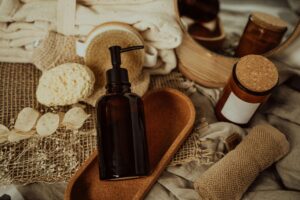Our homes are meant to be safe spaces, but many everyday items we use contain chemicals known as endocrine disruptors, which can impact our health in ways we may not even realize. These substances can interfere with the body’s hormonal system, impacting processes like metabolism, growth, and mood.
The good news? You don’t have to overhaul everything to make a meaningful change. By learning how to spot and avoid common sources of endocrine disruptors, you can start making choices that support a healthier, safer home.
In this guide, you’ll find practical tips for reducing your exposure, empowering you to create a space that aligns with your wellness goals.
What are endocrine disruptors?
Endocrine disruptors are chemicals that can interfere with the endocrine (or hormonal) system in our bodies. Hormones act as chemical messengers, helping to regulate growth, mood, metabolism, and even sleep. Endocrine disruptors can mimic, block, or interfere with hormones, potentially leading to health issues over time.
Common endocrine disruptors include chemicals like BPA, phthalates, parabens, and certain pesticides. These substances are often found in plastic containers, personal care products, cleaning supplies, and even some types of food packaging.
8 Ways to avoid endocrine disruptors in your day-to-day life
1. Choose BPA-free containers and avoid plastic when possible
Bisphenol A, or BPA, is a common endocrine disruptor found in certain plastics, especially in plastic food storage containers, water bottles, and the lining of canned goods. BPA can leach into food and drinks, particularly when containers are heated or scratched.
To reduce BPA exposure, opt for BPA-free labeled products or, better yet, choose glass or stainless steel containers for storing food and beverages. Additionally, avoid microwaving food in plastic containers, as this can increase the chances of BPA leaching.
Quick tip: If you can’t avoid plastic altogether, look for recycling codes on containers. Plastics labeled with codes 1, 2, 4, and 5 are generally considered safer, while 3, 6, and 7 may contain harmful chemicals like BPA or phthalates.
2. Switch to fragrance-free or naturally scented products
Fragrances are added to many household products, from cleaners and air fresheners to laundry detergents and personal care items. However, synthetic fragrances often contain phthalates, a type of endocrine disruptor used to help scents last longer. Phthalates can be absorbed through the skin or inhaled, contributing to hormone disruption over time.
When possible, choose fragrance-free versions of products or look for options scented with natural essential oils. Many brands now offer fragrance-free or naturally scented alternatives, making it easier to reduce exposure to synthetic fragrances in your home.
3. Avoid products with parabens
Parabens are commonly used as preservatives in cosmetics and personal care products like shampoos, lotions, and cosmetics. They help prevent mold and bacteria from growing, which extends the product’s shelf life. However, parabens are known to mimic estrogen, a hormone that plays a role in both male and female reproductive systems. Over time, this hormonal mimicry can potentially lead to health issues.
To avoid parabens, check product labels for ingredients ending in “-paraben,” such as methylparaben, ethylparaben, or propylparaben. Many brands now offer paraben-free versions of their products, so it’s becoming easier to find safe alternatives.
4. Opt for natural cleaning products
Conventional cleaning products often contain a mix of chemicals that can act as endocrine disruptors, especially if they include harsh solvents, artificial fragrances, or certain surfactants. To reduce exposure, consider using natural cleaning alternatives made from ingredients like vinegar, baking soda, and castile soap. Many natural or “green” cleaning brands now offer products free from phthalates, artificial fragrances, and other chemicals of concern.
You can also make simple homemade cleaners, such as an all-purpose spray made with water and white vinegar. Adding a few drops of essential oil can give your homemade cleaner a fresh scent without the use of synthetic fragrances.
5. Choose non-toxic personal care products
Personal care items like lotions, shampoos, deodorants, and cosmetics can be common sources of endocrine disruptors. In addition to parabens and phthalates, personal care products may contain other disruptors like triclosan (an antibacterial agent) and certain UV filters used in sunscreens. Checking ingredient labels is key to avoiding these chemicals.
Look for products labeled “paraben-free,” “phthalate-free,” and “triclosan-free.” Additionally, many clean beauty brands offer products free from common endocrine disruptors, making it easier to find safe options. If you’re looking to switch products gradually, consider starting with items that stay on your skin the longest, like moisturizers, lotions, and deodorants.
6. Avoid canned foods or choose BPA-free canned options
Many canned foods have linings that contain BPA, which can leach into the food inside, particularly if it’s acidic (like tomatoes). Over time, this exposure can add up, especially if you consume canned foods regularly. Choosing fresh or frozen options instead of canned when possible is one way to reduce exposure to BPA.
If you do purchase canned foods, look for brands that specifically state they use BPA-free liners. Many companies are now moving away from BPA in their packaging, but checking labels or reaching out to brands directly can provide added reassurance.
7. Filter your tap water
Some endocrine disruptors, such as pesticides and industrial chemicals, can end up in tap water. Using a water filter can help remove a range of contaminants, providing cleaner water for drinking, cooking, and even showering.
Look for a filter that’s designed to reduce contaminants like BPA, pesticides, and heavy metals. Activated carbon filters, reverse osmosis systems, and NSF-certified filters are often effective at reducing endocrine disruptors in water.
8. Be mindful of receipts
Thermal paper receipts are often coated with BPA or BPS, which can be absorbed through the skin. While touching receipts occasionally isn’t likely to pose a huge risk, reducing contact can help minimize exposure.
If possible, choose digital receipts, especially if you work in retail or handle receipts frequently. If you must handle a receipt, wash your hands immediately afterwards to help limit exposure.
Take steps to avoid endocrine disruptors
By gradually swapping in safer options, checking ingredient labels, and making a few simple changes, you can significantly reduce your exposure to these chemicals. Small, mindful adjustments—like choosing fragrance-free products, switching to natural cleaners, or filtering your tap water—can make a big difference over time.
With these practical tips, you can create a low tox home environment that supports your well-being and helps protect your family from unnecessary chemical exposure.







